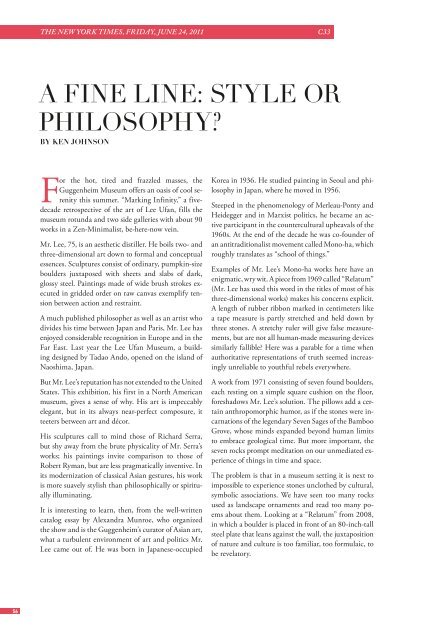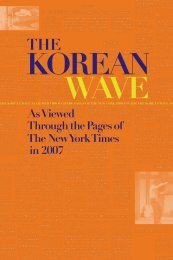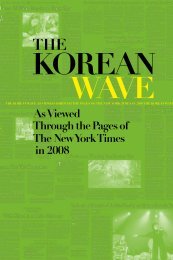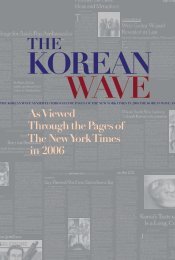The Korean Wave 2010-2011 - Korean Cultural Service
The Korean Wave 2010-2011 - Korean Cultural Service
The Korean Wave 2010-2011 - Korean Cultural Service
Create successful ePaper yourself
Turn your PDF publications into a flip-book with our unique Google optimized e-Paper software.
<strong>The</strong> New York Times, FRIDAY, JUNE 24, <strong>2011</strong>C33A Fine Line: Style orPhilosophy?By KEN JOHNSONFor the hot, tired and frazzled masses, theGuggenheim Museum offers an oasis of cool serenitythis summer. “Marking Infinity,” a fivedecaderetrospective of the art of Lee Ufan, fills themuseum rotunda and two side galleries with about 90works in a Zen-Minimalist, be-here-now vein.Mr. Lee, 75, is an aesthetic distiller. He boils two- andthree-dimensional art down to formal and conceptualessences. Sculptures consist of ordinary, pumpkin-sizeboulders juxtaposed with sheets and slabs of dark,glossy steel. Paintings made of wide brush strokes executedin gridded order on raw canvas exemplify tensionbetween action and restraint.A much published philosopher as well as an artist whodivides his time between Japan and Paris, Mr. Lee hasenjoyed considerable recognition in Europe and in theFar East. Last year the Lee Ufan Museum, a buildingdesigned by Tadao Ando, opened on the island ofNaoshima, Japan.But Mr. Lee’s reputation has not extended to the UnitedStates. This exhibition, his first in a North Americanmuseum, gives a sense of why. His art is impeccablyelegant, but in its always near-perfect composure, itteeters between art and décor.His sculptures call to mind those of Richard Serra,but shy away from the brute physicality of Mr. Serra’sworks; his paintings invite comparison to those ofRobert Ryman, but are less pragmatically inventive. Inits modernization of classical Asian gestures, his workis more suavely stylish than philosophically or spirituallyilluminating.It is interesting to learn, then, from the well-writtencatalog essay by Alexandra Munroe, who organizedthe show and is the Guggenheim’s curator of Asian art,what a turbulent environment of art and politics Mr.Lee came out of. He was born in Japanese-occupiedKorea in 1936. He studied painting in Seoul and philosophyin Japan, where he moved in 1956.Steeped in the phenomenology of Merleau-Ponty andHeidegger and in Marxist politics, he became an activeparticipant in the countercultural upheavals of the1960s. At the end of the decade he was co-founder ofan antitraditionalist movement called Mono-ha, whichroughly translates as “school of things.”Examples of Mr. Lee’s Mono-ha works here have anenigmatic, wry wit. A piece from 1969 called “Relatum”(Mr. Lee has used this word in the titles of most of histhree-dimensional works) makes his concerns explicit.A length of rubber ribbon marked in centimeters likea tape measure is partly stretched and held down bythree stones. A stretchy ruler will give false measurements,but are not all human-made measuring devicessimilarly fallible? Here was a parable for a time whenauthoritative representations of truth seemed increasinglyunreliable to youthful rebels everywhere.A work from 1971 consisting of seven found boulders,each resting on a simple square cushion on the floor,foreshadows Mr. Lee’s solution. <strong>The</strong> pillows add a certainanthropomorphic humor, as if the stones were incarnationsof the legendary Seven Sages of the BambooGrove, whose minds expanded beyond human limitsto embrace geological time. But more important, theseven rocks prompt meditation on our unmediated experienceof things in time and space.<strong>The</strong> problem is that in a museum setting it is next toimpossible to experience stones unclothed by cultural,symbolic associations. We have seen too many rocksused as landscape ornaments and read too many poemsabout them. Looking at a “Relatum” from 2008,in which a boulder is placed in front of an 80-inch-tallsteel plate that leans against the wall, the juxtapositionof nature and culture is too familiar, too formulaic, tobe revelatory.In paintings from the last four decades, Mr. Lee hasmade the brush stroke his primary device, often tooptically gripping and lyrical effect. In the ’70s hepursued two approaches, always using just one colorper canvas — usually blue, red or black.In one series he used a paint-loaded brush to make horizontalrows of squarish marks one after another, eachpaler than its predecessor, as the paint was used up. Hethereby created gridded fields of staccato patterning.In other paintings he used wide brushes to make long,vertical stripes, dark at the top and fading toward thebottom. <strong>The</strong>y give the impression of stockade fencingobscured near the ground by low-lying fog.In the ’80s Mr. Lee loosened up his strokes and beganto produce airy, monochrome compositions in a kindof Abstract Expressionist style driven not by emotionalangst but by delight in existential flux. This periodculminates at the end of the decade in canvases denselycovered by squiggly gray marks that are among theexhibition’s most compelling.From the mid-’90s on, Mr. Lee pared down his paintings,arriving four years ago at a particular modularform: an oversize brush stroke shaped like a slice ofbread and fading from black to pale gray. He uses thisdevice to punctuate sparingly large, otherwise blank,off-white canvases. Here, as with the stone and steelworks, preciousness trumps phenomenology.But something different and more exciting happensin a site-specific work that ends the show. In an approximatelysquare room, Mr. Lee painted one of hisgray-black modules directly on each of three walls. Asurprising tension between the materiality of the paintand an illusion of space arises. <strong>The</strong> modules becomelike television screens or airplane windows, affordingviews of indefinite, possibly infinite space beyond themuseum walls. It makes for a fine wedding of the realand the metaphysical.“Lee Ufan: Marking Infinity,” runs through Sept. 28 at theGuggenheim Museum, 1071 Fifth Avenue, at 89th Street;(212) 423-3500, guggenheim.org.56Copyright © <strong>2011</strong> by <strong>The</strong> New York Times Co. Reprinted with permission.57





